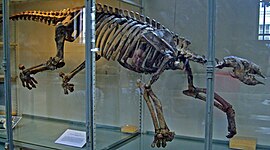
Kingdom: Animalia
Phylum: Chordata
Class: Mammalia
Order: Pilosa
Family: Nothrotheriidae
Genus: Thalassocnus
Species: T. antiquus
T. natans
T. littoralis
T. carolomartini
T. Yaucensis
Temporal Range: Late Miocene to Late Pliocene
It is an extinct genus of semi-aquatic or fully aquatic marine sloth from the Miocene and Pliocene of South America. Fossils found to date have been from the coast of Peru and Chile. They were apparently grazers of sea grass and seaweed. The various species of this genus provides the best-documented case of gradual adaptation ti a secondary aquatic lifestyle. This is documented both at the morphological level, such as a progressive flattening of the radius.and at the micro anatomical level, which shows a progressive increase in thickness and compactness of the long limb bones and ribs, providing ballast. They may have used their powerful claws to anchor themselves to the sea floor to facilitate feeding, simmilar to the behavior of the marine iguana.
The oldest species, T. antiquus, T. natans and T. littoralis show indications of partial adaptation to grazing with little evidence of transverse mandibular movement while eating, and abundant dental striae indicating ingestion of sand from feeding on vegetation stranded on beaches or or in shallow water. The later species T. carolomartini and T. yaucensis were apparently specialized grazers that fed in deeper water, they display distinct evidence of transverse mandibular movement and lack dental striae.
No comments:
Post a Comment